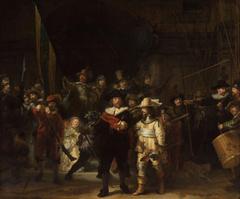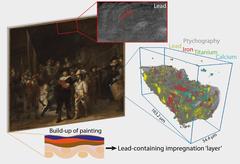URL: https://www.desy.de/news/news_search/index_eng.html
Breadcrumb Navigation
DESY News: Innovation in the 17th century: Rembrandt impregnated the canvas for The Night Watch with lead
News
News from the DESY research centre
Innovation in the 17th century: Rembrandt impregnated the canvas for The Night Watch with lead
Rembrandt impregnated the canvas for his famous painting “The Night Watch” from 1642 with a lead-containing substance even before applying the first ground layer. This has been revealed by new investigations carried out at DESY's brilliant X-ray source PETRA III. Such a lead-based impregnation has never before been observed with Rembrandt or his contemporaries. The discovery by an international research team, which was published today in the journal Science Advances, underlines Rembrandt's inventive way of working, in which he did not shy away from using new techniques.

Rembrandt´s famous painting The Night Watch. Using a tiny sample analysed at the PETRA III particle accelerator, an international research team has now been able to prove that Rembrandt impregnated it using a new technique. Photo: Rijksmuseum, Amsterdam
Protection against moisture
It was already known from earlier studies that Rembrandt had used a quartz-clay ground on the Night Watch. In earlier paintings he had used double grounds, consisting of a first ground containing red earth pigments followed by a second lead white containing ground. The large size of The Night Watch, measuring more than three and a half by four metres, may have motivated Rembrandt to look for a cheaper, less heavy, and more flexible alternative for the ground layer. Another issue he had to overcome was that the large canvas was intended for a damp outer wall of the great hall of the Kloveniersdoelen (musketeers' shooting range) in Amsterdam. It had been reported that under humid conditions the common method of preparing the canvas using animal glue could fail. A contemporary source on painting techniques written by Théodore de Mayerne suggested impregnation with lead-rich oil as an alternative. This may have inspired Rembrandt for his unusual impregnation procedure to improve the durability of his masterpiece.
Computational imaging
The presence of this lead-containing ‘layer’ was discovered by the first-ever use of correlated X-ray fluorescence and ptychographic nano-tomography on a historical paint sample. These investigations were performed at PETRA III beamline P06 at DESY. X-ray fluorescence is used to investigate the distribution of relatively heavy elements (calcium and heavier). Ptychography, a computational imaging technique based on experimentally obtained datasets, is capable of visualizing even the lightest elements and organic fractions.
Analysis of the micro sample taken from The Night Watch revealed that on the side of the sample closest to the canvas support a homogenous layer of dispersed lead was present in the ground layer. Since lead components were not to be expected in the quartz-clay ground layer, this was a rather puzzling observation. The results were then combined with the lead distribution map of the full Night Watch, obtained by X-ray fluorescence scanning of the painting in the Rijksmuseum’s Gallery of Honour. This map reveals the presence of lead throughout the painting and suggests application using large semi-circular brushstrokes, supporting the assumption that it results from an impregnation procedure. “Even an imprint of the original strainer bar onto which the canvas was stretched when the preparatory layers were applied, is visible in the lead distribution map. This brings us yet another step closer to understanding Rembrandt’s creative process in painting The Night Watch, as well as its current condition,” says Fréderique Broers. She is a researcher at the Rijksmuseum and Ph.D. student at the Universities of Amsterdam, Antwerp, and Utrecht. Her supervisors are Katrien Keune, Koen Janssens, and Florian Meirer.

Graphical abstract of the work: The researchers discovered a previously unknown lead-containing impregnation layer in Rembrandt's Night Watch. They used synchrotron X-ray fluorescence and ptychographic tomography of a painting sample, supported by a macroscopic X-ray fluorescence scan of the entire painting. Picture: Fréderique Broers, Rijksmuseum / Science Advances.
Reference
Fréderique T.H. Broers*, Ige Verslype, Koen W. Bossers, Frederik Vanmeert, Victor Gonzalez, Jan Garrevoet, Annelies van Loon, Esther van Duijn, Anna Krekeler, Nouchka De Keyser, Ilse Steeman, Petria Noble, Koen Janssens, Florian Meirer*, Katrien Keune: Correlated x-ray fluorescence and ptychographic nanotomography on Rembrandt’s The Night Watch reveals unknown lead “layer”. Science Advances, 15 December 2023. DOI: 10.1126/sciadv.adj9394
* corresponding authors



